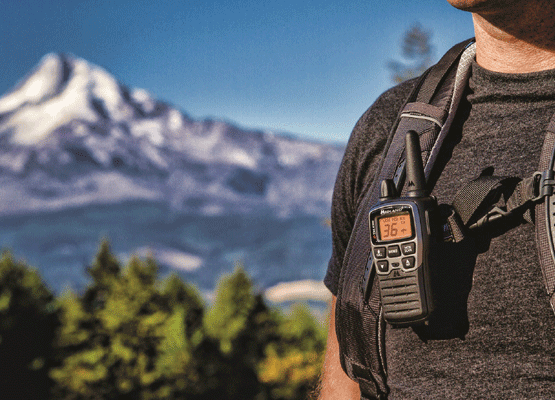What to Look for When Buying a Walkie Talkie

Table of Contents
If you’re looking to buy professional walkie talkies, you might be surprised by just how many different features, frequencies, ranges, and brands there are to choose from. It might seem tricky finding your perfect handheld walkie talkie amongst the hundreds of different options that range from products that are basically toys to military or emergency services grade tools trusted in dire situations. Most people shopping for a walkie talkie need something in between the two, something reliable, clear sound quality, and durable that will get the job done. Keep reading our walkie talkie buying guide to find the best option for you.
From Professional to Recreational Use and Everything in Between, Midland is Your Walkie Talkie Headquarters
Different Types of Walkie Talkies
Of all the two-way radios out there, most can be divided into two categories: business or consumer. Business radios include everything from the serious units adopted by the military or police to walkie talkies that keep workers connected on construction sites, in warehouses, or during field work. Walkie talkies for consumer use are the sort you’ll take hiking, on a family vacation, at a theme park, or hitting a music festival.
From there, you can see most other frequencies, features, and types of radio fall along those two categories. Business walkie talkies, for example, are more likely to be UHF (ultra high frequency) or VHF (very high frequency). The difference between those two designations is that ultra high frequency radios have a more penetrative signal that works better indoors or in urban settings. UHF walkie talkies are ideal for businesses that operate in cities, across campuses, and where workers are going in and out of doors all day.
VHF walkie talkies, on the other hand, are better in wide open spaces. They can cover longer distances with less drain on your battery if you’re in an area with few obstacles, like a meadow or a golf course or on the lake. They are more functional outdoors, or anywhere with a clear line of sight, like from one mountain peak to another, or between two vehicles offroading.
What’s The Difference Between UHF/VHF and GMRS/FRS Walkie Talkies?
Below the high megahertz frequencies used by UHF and VHF walkie talkies are the frequencies used by GMRS and FRS walkie talkies. The later frequencies are what usually fall into the consumer category. Keep in mind that GMRS does require special licensing from the FCC ($35 for 10 years), while FRS does not. FRS handheld radios aren’t quite as powerful in terms of their range or penetrative capabilities, but the vast majority of the time, you don’t need them to be.
FRS is the best walkie talkie choice if you’re camping, keeping track of your family at the beach, or hanging out at an outdoor concert, because you don’t need to worry about spanning miles between ships or communicating with someone underground or in a concrete building. You’re far more likely to be touching base with your partner who’s down at the lake half a mile away to see if he’s caught anything for dinner and if you should get the fire going, or reminding your kids that they need to be home by sunset.
Other Walkie Talkie Features
Once you have your needs narrowed down to a particular frequency type, then you can start thinking about features based on what kind of activities you want to enjoy with your walkie talkie.
The Midland X-Talker T10 model, for example is a FRS radio that is water resistant, offers a keypad lock, weather alerts, battery life extender, and silent operation mode. That’s a great option for occasional use at picnics, after school functions, or short hikes.
The X-Talker T51 offers all those features as well as the legendary Midland weather scan, headphone jack, micro USB charge, and rechargeable batteries. Those features are ideal for someone who will routinely use a walkie talkie and put it through its paces on camping or fishing trips, off road adventures, or longer regular excursions, like weekend orienteering or geotagging sessions.
The GXT1050VP4 has all of these features plus Xtreme range as it is a GMRS 5-watt radio. The GXT1050 also includes Mossy Oak camouflage, whisper mode, vibration alerts, and an SOS siren. These are all features included with hunters in mind, or anyone who goes deeper into the backcountry. Someone who takes the kids to Disney World once a month or has a few business meetings a year out on the links isn’t going to need a walkie talkie with this type of power.
There are too many models and features to list here, so take a look at this handy walkie talkie comparison guide. Now that you’re better acquainted with the value of different frequencies, you can quickly identify a few Midland handheld radios that would meet your needs and narrow down your options from there. Have fun picking out a new walkie talkie!


